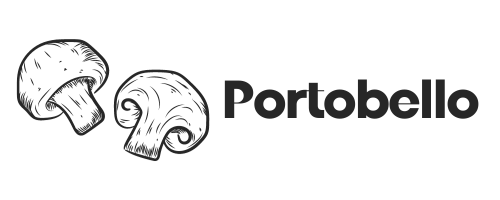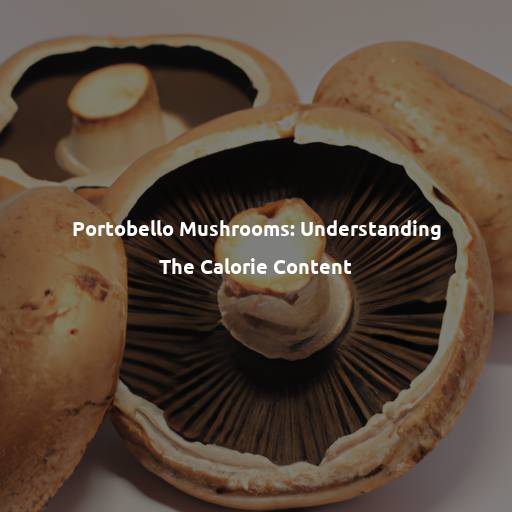Introduction to Portobello Mushrooms
Portobello mushrooms, also known as the king of mushrooms, are a popular choice for their meaty texture and rich flavor. These mushrooms are characterized by their large, flat caps, which make them versatile for cooking. From grilling and roasting to stuffing and sautéing, there are countless ways to incorporate portobello mushrooms into your meals. Whether you’re a vegetarian looking for a hearty meat substitute or simply a mushroom lover, understanding the nutritional benefits and calorie content of portobello mushrooms is essential for making healthy and delicious dietary choices. In this section, we will dive into the world of portobello mushrooms and explore their unique qualities that make them a must-have ingredient in any kitchen.
Nutritional Profile of Portobello Mushrooms
Portobello mushrooms are not only delicious but also packed with essential nutrients. These mushrooms belong to the Agaricus genus and are known for their large and meaty caps. They are a rich source of vitamins, minerals, and antioxidants, making them a great addition to a healthy diet.
One of the notable nutrients found in portobello mushrooms is potassium. Potassium is an essential mineral that helps regulate blood pressure and maintain proper heart function. Consuming portobello mushrooms can contribute to your daily recommended intake of potassium.
Portobellos are also rich in B vitamins, including riboflavin (vitamin B2), niacin (vitamin B3), and pantothenic acid (vitamin B5). These vitamins play a crucial role in energy metabolism and the proper functioning of various systems in the body.
Additionally, portobello mushrooms are a good source of dietary fiber. Fiber aids in promoting digestive health, maintaining stable blood sugar levels, and promoting feelings of fullness and satiety.
When it comes to minerals, portobello mushrooms contain significant amounts of selenium, copper, and phosphorus. Selenium is an essential antioxidant that helps protect cells from damage, while copper contributes to the production of red blood cells. Phosphorus is essential for healthy bone formation and helps maintain healthy teeth.
Antioxidants play a vital role in protecting the body from harmful free radicals. Portobello mushrooms contain various antioxidants, including ergothioneine and selenium, which help reduce oxidative stress and inflammation.
Overall, portobello mushrooms are a nutrient-dense food choice that can provide many health benefits. By incorporating these mushrooms into your diet, you can enjoy their delicious flavor while nourishing your body with essential vitamins, minerals, and antioxidants.
Calories in Portobello Mushrooms
Portobello mushrooms are not only delicious but also incredibly low in calories. A 100-gram serving of raw portobello mushrooms contains only about 22 calories. This makes them an excellent choice for those who are watching their calorie intake.
Despite their low calorie content, portobello mushrooms offer a wealth of nutrients. They are a good source of dietary fiber, providing about 1 gram per 100 grams. Additionally, they contain important vitamins and minerals such as potassium, phosphorus, and selenium.
Incorporating portobello mushrooms into your meals can help you create flavorful dishes without adding excessive calories. They are versatile and can be used as a meat substitute in various recipes, such as portobello mushroom burgers or grilled portobello steaks.
It’s worth noting that the calorie content can vary depending on the cooking method. For example, grilling or baking portobello mushrooms with a little bit of olive oil may slightly increase their calorie content, but it’s still relatively low compared to other ingredients.
In conclusion, portobello mushrooms are a fantastic addition to any low-calorie diet. With their minimal calorie content and abundance of nutrients, you can enjoy these flavorful fungi without guilt.
Factors Affecting Calorie Content
1. Size: The size of the portobello mushroom naturally affects its calorie content. Larger mushrooms tend to have slightly higher calorie counts compared to smaller ones. Therefore, it is important to consider the size of the mushroom when determining its caloric value.
2. Cooking Method: The cooking method used can also impact the calorie content of portobello mushrooms. Grilling or broiling portobello mushrooms without excessive amounts of oil or butter can help retain their low-calorie nature. On the other hand, sautéing or frying the mushrooms in oil or butter can increase their calorie content.
3. Stuffings and Seasonings: When preparing stuffed portobello mushrooms or adding seasonings, it is essential to consider their potential impact on the calorie content. Caloric additions such as cheese, breadcrumbs, or high-fat sauces can significantly increase the overall calorie count of the dish.
4. Toppings: Toppings used on portobello mushroom dishes can also contribute to their calorie content. For instance, adding bacon, high-fat dressings, or mayonnaise-based sauces can significantly increase the calorie count. Opting for healthier toppings like fresh herbs, low-calorie sauces, or vegetables can help keep the calorie content in check.
5. Consumption Portions: Lastly, the amount of portobello mushrooms consumed directly affects the calorie intake. While portobello mushrooms are relatively low in calories, consuming large portions regularly can still contribute to overall calorie intake. Moderation is key when incorporating them into a balanced diet.
By considering these factors that influence the calorie content of portobello mushrooms, you can make informed choices and enjoy them as a nutritious and delicious part of your diet.
Incorporating Portobello Mushrooms into a Healthy Diet
Portobello mushrooms are not only delicious but also a great addition to a healthy diet. Incorporating these nutrient-rich mushrooms into your meals can provide numerous health benefits. Whether you’re a vegetarian, vegan, or simply looking to add more plant-based foods to your diet, here are some ideas on how to include portobello mushrooms into your daily meals:
1. Portobello Mushroom Burgers: Swap out traditional beef patties with portobello mushrooms for a healthier alternative. Grilled or baked, these mushrooms create a meaty and satisfying burger option. Top with your favorite vegetables and condiments for added flavor.
2. Portobello Mushroom Steaks: Portobello mushrooms can be marinated and cooked to resemble a juicy steak. Brush them with a mixture of olive oil, balsamic vinegar, garlic, and herbs, then grill or broil to perfection. Serve them alongside roasted vegetables or whole grains for a complete meal.
3. Stuffed Portobello Mushrooms: One way to get creative with portobello mushrooms is to stuff them with delicious fillings. Combine sautéed vegetables, quinoa, or even cheese for a flavorful and satisfying dish. Bake until the mushrooms are tender and the filling is golden brown.
4. Portobello Mushroom Pizzas: Instead of traditional pizza crust, use large portobello mushroom caps as a base. Top them with tomato sauce, cheese, and your favorite toppings. Bake in the oven until the cheese is melted and bubbly, and enjoy a guilt-free pizza alternative.
5. Portobello Mushroom Stir-Fry: Add sliced portobello mushrooms to your favorite stir-fry recipe for an extra boost of flavor and texture. Cook them alongside colorful vegetables, protein of your choice, and a flavorful sauce. Serve over brown rice or noodles for a well-balanced and nutritious meal.
Remember, portobello mushrooms have a meaty texture and rich flavor, making them a versatile ingredient in various dishes. Get creative in the kitchen and experiment with different recipes to incorporate these nutritious mushrooms into your healthy diet. Enjoy the unique taste and benefits they bring to your meals!
Conclusion: Enjoying Portobello Mushrooms in Moderation
By incorporating portobello mushrooms into your diet in moderation, you can enjoy their delicious flavor while reaping the benefits of their nutrient-dense profile. With their low calorie content and abundance of vitamins, minerals, and antioxidants, portobello mushrooms are a fantastic addition to any healthy eating plan. Whether you choose to grill them for a meaty burger alternative, stuff them with flavorful fillings, or use them as a base for pizza, these versatile mushrooms can elevate your meals without adding excessive calories. Remember to consider factors such as portion size, cooking method, stuffings, seasonings, and toppings to make informed choices and keep the calorie content in check. Get creative in the kitchen and enjoy the unique taste and health benefits that portobello mushrooms bring to your table.

